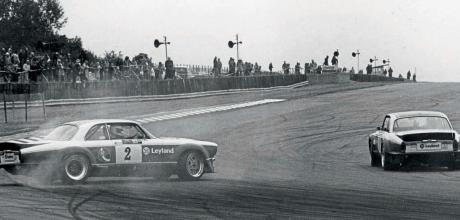The Broadspeed Jaguar XJ12C’s final finish, Silverstone, 1977
There was plenty of excitement when it was announced in March 1976 that Jaguar was to participate in the European Touring Car Championship. Not only was the powerful 5.3-litre XJ12 Coupe chosen to compete in the BMW-dominated series but it would be prepared and entered by Ralph Broad’s successful Broadspeed Engineering outfit.
Finishing Lines
But from start to finish, the project was largely an unmitigated disaster. To begin with, other than a one-off appearance at Silverstone that year when a single entry retired, the car wasn’t ready until the following season. And even then, due to their fragility, the two cars entered would usually retire.
Yet there were a few moments to celebrate, such as teammates Andy Rouse and Derek Bell plus John Fitzpatrick and Tim Schenken taking pole at four of the season’s opening seven races. Plus Bell and Rouse finished a fine second at the Nürburging in July.
And then came Silverstone for the famed Tourist Trophy in September. As the sole British round of the championship and the 12-month anniversary of the car’s debut, it was the race the team wanted to win above all others. With the fast nature of the track suiting the powerful V12-engined coupe, it was widely felt this was where it would all come good and the Jaguar would take its first victory.
The team gave itself the best chance to do so when Rouse and Bell took pole with Schenken and Fitzpatrick right behind, the lead Jaguar almost 0.7 seconds faster than BMW 3.0 CSL E9 of Dieter Quester and Tom Walkinshaw in third.
From a 100mph rolling start, the partisan crowd watched as Schenken quickly took the lead when Rouse’s XJ12 spluttered with a temporary fuel injection malfunction. The two Jaguars were immediately put under heavy pressure from the several BMWs close behind and on lap four Schenken spun at Copse leaving Rouse to take the lead (pictured).
For the next 24 laps Schenken diced with the BMW of Quester to regain second, the German car often out-braking the Jaguar into corners only for the XJ12 to whoosh past on the straights. This fantastic dual finally came to an end when the Jaguar’s front hub broke leaving it a tricycle.
Rouse, meanwhile, carried on at the front which continued when Bell took over, the British driver putting in the sort of gutsy drive that had netted him victory in the 1975 24 Hours of Le Mans (plus four more in the future).
When Rouse took over with 24 laps to go for the final stint, the half-minute pitstop had demoted the Jaguar 19.2 seconds behind the Quester/Walkinshaw BMW which was soon cut to 14.9. Despite the packed stands willing Rouse to catch and then pass the German car, he lost the big coupe as he approached Abbey, sliding into the barrier. Although the car wasn’t badly damaged and Rouse was able to return to the track, any chance of a victory was lost and he crossed the line in fourth. Although the team – like the crowd – was disappointed it hadn’t won, considering the season it had endured so far, crossing the line was still a positive result.
Yet Silverstone would be the final time an XJ12 finished a race. After both cars again retired from the next round at Zolder, Jaguar’s parent company Leyland pulled the plug on the project before the season was out, missing the last two at Jarama and Estoril. As Motorsport magazine said about the Tourist Trophy in its November 1977 issue, “It had been a thoroughly good motor race but with a sad result for the home team. They could have easily won; now the cars will just fade into history.”


